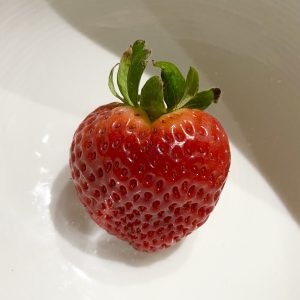Chapter 7: Semantics
7.1 Linguistic meaning
We use the word “meaning” in various ways in our everyday lives. Consider (1)-(4).
| (1) | mean | ||||||||||||||||||||||
| (2) |
|
||||||||||||||||||||||
| (3) | I said coffee is just as tasty as tea, but I didn’t mean it. | ||||||||||||||||||||||
| (4) | Ode’imin and strawberry mean | ||||||||||||||||||||||
| (Examples inspired by Bach 1989) | |||||||||||||||||||||||

linguistic meaning: the sorts of things we have to know as language users when we produce and comprehend meaning. This excludes notions of “meaning” like in (1). (1) is not an example of linguistic meaning because the floating tea stalk (the object depicted in Figure 7.1) is not a linguistic expression. Sometimes we use the word mean or meaning
(2) also describes a kind of “meaning” that isn’t linguistic. Literally, the Japanese sentence in (2) means ‘There is no meaning in buying an expensive sewing machine if you don’t know how to use it’. This use of imi, or meaning, is about the purpose of some action. Here, we are saying that there is a relation between an action and some sort of ideal end result that the act is supposed to lead to. This, again, is not the kind of “meaning” we are interested in in this textbook.
The notion of meaning in (3) is certainly about language, in the sense that we are evaluating what someone said. “Meaning” here seems to be something about sincerity: (3) is roughly paraphrasable as ‘I said coffee is just as tasty as tea, but I wasn’t being sincere when I said this’. This is not the kind of “meaning” we will be concerned with in this particular chapter, but Chapter 8 (Pragmatics) will discuss some points that will be relevant to this notion of “meaning”.

“Meaning” as used in (4) best exemplifies what we mean by meaning (= linguistic meaning) in this chapter: the words ode’imin and strawberry mean the same thing. ode’imin is an Ojibwe (Anishinaabemowin) word, and strawberry is an English word. But what does it mean for them to “mean the same thing”? Wode’imin
Note that when we say “the meaning of ode’imin“, we are talking about the meaning of the linguistic expression ode’imin, not the actual fruit in real life. In this chapter, we are asking what meaning is attached to the stream of sounds ode’imin (IPA: [odeimin]) in Ojibwe, not to the actual fruit like in Figure 7.2. Similarly, we are asking what meaning is attached to the stream of sounds strawberry (IPA: [stɹɔbɛɹi]), again, not to the actual fruit. For signed languages, we want to know what meaning is attached to a certain sign: like what is shown in Figure 7.3, which is the sign for ‘strawberry’ in American Sign Language. Linguistic expressions are the words, phrases, and sentences we produce as language users. Following writing conventions in linguistics, linguistic expressions that are mentioned in paragraphs will be italicized in this textbook. So when we write “strawberry” (in italics), we are referring to the linguistic expression (the word) that points to the object in Figure 7.2. When we write “strawberry” (no italics), we are actually talking about the object in Figure 7.2, the actual fruit. So “the strawberry
Figure 7.3. Three variations of the word ‘strawberry’ in American Sign Language.
Semantics is the study of linguistic meaning: how the meaning of words combine to form the meaning of sentences. In this chapter, we will analyse linguistic meaning from various perspectives. One of the big conclusions of this chapter (Chapter 7) and the next chapter (Chapter 8, Pragmatics) is that there are many different kinds of linguistic meaning. Each way of thinking about meaning gives us important insight into how we produce and understand meaning as language users. We will start this chapter by looking at what people probably usually think of when they hear “meaning”: the sense of words that we store in our heads. The sense of strawberry would be whatever “meaning” of that word English users store in their head. After our discussion of sense, we will look at meaning in terms of the denotation of linguistic expressions: what linguistic expressions point to in the real world. As we’ve seen already, one way of thinking about how ode’imin and strawberry “mean the same thing” is to say that these words both point to (or denote) the same fruit in the actual world. As we will see, thinking about meaning in terms of the linguistic expression’s denotation also helps us explain semantic patterns in language.
Check your understanding
References
Bach, E. (1989). Informal lectures on formal semantics. State University of New York Press.
Frege, G. (1892). Über sinn und bedeutung. Zeitschrift für Philosophie und philosophische Kritik, 100, 25-50.
“semantics, n.” OED Online. Oxford University Press, December 2021. Web. 21 February 2022.
“strawberry, n.” OED Online. Oxford University Press, December 2021. Web. 22 February 2022.

